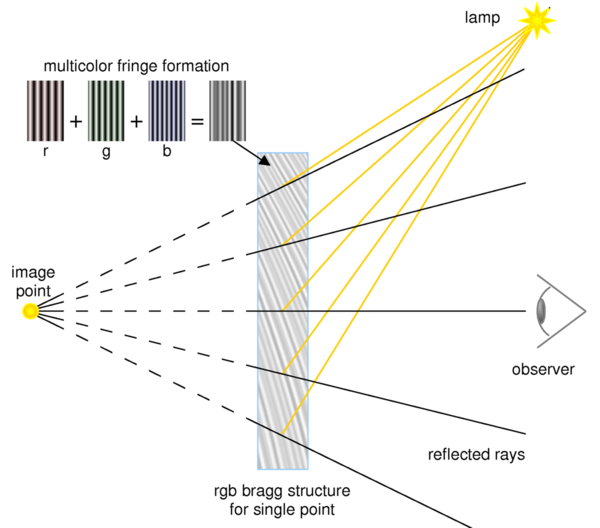Formation of a single image point in a white light hologram

Exposure with r, g and b lasers results in overlaid bragg
structures
for the three colors. These structures reflect only three narrow bands
r,g, and b from the light source. They act like a convex mirror that
delivers a small image of the light source, which actually is what we
see as one point in the holographic image. Hence, the size of the light
source limits the resolution.
The illustration also shows the bragg layers becoming thicker with
shallower incident/outgoing light angles, to correspond to the same
wavelength.
Further, the spectral selectivity of the bragg structures rises with
their total thickness (this is quite similar to a Fourier transform of
the spatial bragg structure to the frequency domain). Thin bragg
structures (down to a single faint refraction index boundary surface,
that would just behave like an ordinary mirror) reflect a wider
spectral range, but still at defined angles forming image points. The
hologram, viewed with a halogen lamp, then looks white or only little
colored, even if it was recorded with a single laser wavelength.
Nevertheless, we can’t record a white light hologram with white light,
as this is not temporally coherent and therefore cannot form stable
fringe patterns. We need one or several coherent, hence monochromatic
sources. Three sources of red, green, and blue (r,g,b,) colors can
provide the illusion of white light to our eyes, they can serve as
primaries for a white or colored hologram. If the r, g, and b parts of
the bragg structure have different strengths, the image point becomes
colored. This reproduces the colors of the recorded image. The white
light hologram then becomes a color hologram. Real holographic film
materials, however, often are sensitive to one color only. Therefor
three separate holograms for r,g, and b, stacked upon each other, are
often used instead of a single, combined one. The light source must be
at the same positions as the reference sources at recording. Otherwise,
color shifts and geometry distortions in the holographic image will
result, because wrong parts of the bragg structures will then reflect
light to the viewer, and they select different color bands from the
light source.
A perfect color hologram in one layer can better be produced
using three laser sources from different directions (e.g., top, left
and right), as in this case the bragg structures cross over at
considerable angles and do not influence each other too much even if
the hologram film does not have perfect properties.
All Rights Reserved.
Redistribution for profit prohibited.